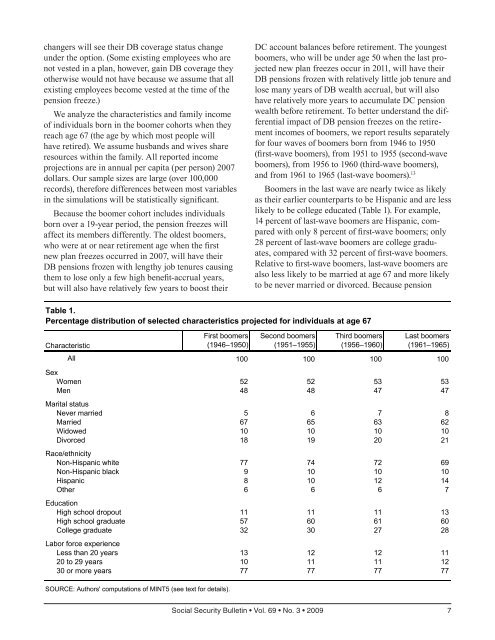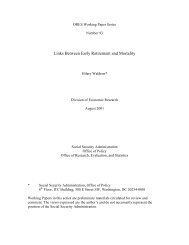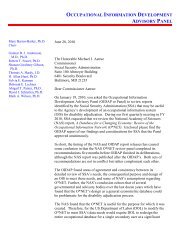Download entire publication - Social Security
Download entire publication - Social Security
Download entire publication - Social Security
You also want an ePaper? Increase the reach of your titles
YUMPU automatically turns print PDFs into web optimized ePapers that Google loves.
changers will see their DB coverage status changeunder the option. (Some existing employees who arenot vested in a plan, however, gain DB coverage theyotherwise would not have because we assume that allexisting employees become vested at the time of thepension freeze.)We analyze the characteristics and family incomeof individuals born in the boomer cohorts when theyreach age 67 (the age by which most people willhave retired). We assume husbands and wives shareresources within the family. All reported incomeprojections are in annual per capita (per person) 2007dollars. Our sample sizes are large (over 100,000records), therefore differences between most variablesin the simulations will be statistically significant.Because the boomer cohort includes individualsborn over a 19-year period, the pension freezes willaffect its members differently. The oldest boomers,who were at or near retirement age when the firstnew plan freezes occurred in 2007, will have theirDB pensions frozen with lengthy job tenures causingthem to lose only a few high benefit-accrual years,but will also have relatively few years to boost theirDC account balances before retirement. The youngestboomers, who will be under age 50 when the last projectednew plan freezes occur in 2011, will have theirDB pensions frozen with relatively little job tenure andlose many years of DB wealth accrual, but will alsohave relatively more years to accumulate DC pensionwealth before retirement. To better understand the differentialimpact of DB pension freezes on the retirementincomes of boomers, we report results separatelyfor four waves of boomers born from 1946 to 1950(first-wave boomers), from 1951 to 1955 (second-waveboomers), from 1956 to 1960 (third-wave boomers),and from 1961 to 1965 (last-wave boomers). 13Boomers in the last wave are nearly twice as likelyas their earlier counterparts to be Hispanic and are lesslikely to be college educated (Table 1). For example,14 percent of last-wave boomers are Hispanic, comparedwith only 8 percent of first-wave boomers; only28 percent of last-wave boomers are college graduates,compared with 32 percent of first-wave boomers.Relative to first-wave boomers, last-wave boomers arealso less likely to be married at age 67 and more likelyto be never married or divorced. Because pensionTable 1.Percentage distribution of selected characteristics projected for individuals at age 67CharacteristicFirst boomers(1946–1950)Second boomers(1951–1955)Third boomers(1956–1960)Last boomers(1961–1965)All 100 100 100 100SexWomen 52 52 53 53Men 48 48 47 47Marital statusNever married 5 6 7 8Married 67 65 63 62Widowed 10 10 10 10Divorced 18 19 20 21Race/ethnicityNon-Hispanic white 77 74 72 69Non-Hispanic black 9 10 10 10Hispanic 8 10 12 14Other 6 6 6 7EducationHigh school dropout 11 11 11 13High school graduate 57 60 61 60College graduate 32 30 27 28Labor force experienceLess than 20 years 13 12 12 1120 to 29 years 10 11 11 1230 or more years 77 77 77 77SOURCE: Authors' computations of MINT5 (see text for details).<strong>Social</strong> <strong>Security</strong> Bulletin • Vol. 69 • No. 3 • 2009 7








